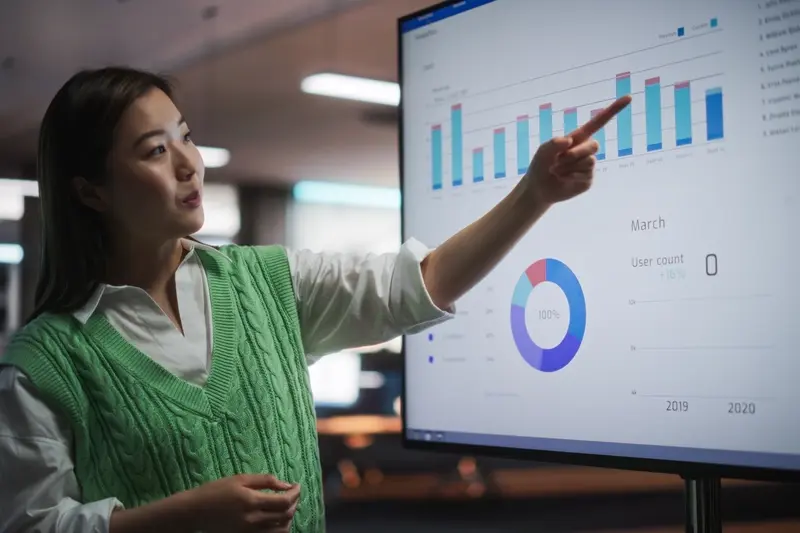What Factors Influence the Mobile App Development Timeline?
Building a mobile app can feel a bit like embarking on an epic quest: exciting and full of potential, yet fraught with challenges and uncertainties. If you’re a business owner looking to dive into app development, you're probably juggling a mix of excitement and anxiety. How long will it take? Will it fit within your budget? What should you prioritise? Understanding the factors that influence the development timeline can really help you plan better, saving you both time and stress.
In this guide, we’re going to walk you through the key aspects that affect how long it takes to build a mobile app. You'll walk away with a clearer picture of the journey ahead, and maybe even a few tips to speed things up without compromising quality.
The best way to predict the future is to create it.Peter Drucker
So let’s dive in and decode the mobile app development timeline together!
The Size of Your App
Let's start with the size. The size of your app is a major player in how long development will take. And by "size," we’re talking about the number of features, screens, and overall content. Imagine you’re at a coffee shop—ordering a simple black coffee is quick and easy, but a large, intricate order with extra syrup, whipped cream, and spices takes a bit longer (and costs more). The same logic applies to app development.
Smaller apps, with fewer features and simpler designs, can often be developed in as little as 2 to 3 months. But if you’re looking at a larger, more complex app with many features—like e-commerce functionalities, social media integration, or extensive database-driven content—it’s going to take longer. These bigger projects need more planning, coding, and rigorous testing.
It’s also worth noting that the size of your app can impact its long-term viability. Larger apps require more maintenance and updates to keep everything running smoothly and to add new features over time. That’s something to consider when mapping out your development timeline and budget. So, if you're a business looking to jump into the mobile app game, it's essential to be realistic about the size and scope of your project.
The Complexity of Your App
Complexity is like adding layers to a cake. The more intricate the flavours, the fancier the icing, the longer it takes to make. Similarly, the more complex your app, with advanced features like augmented reality (AR) or artificial intelligence (AI), the longer it will take to develop. If your app needs to handle a lot of data, integrate with several third-party services, or offer unique functionalities, the timeline will stretch.
Let’s take a banking app as an example. A basic app might let users check their balance and transfer money. This can be developed relatively quickly. Now, if you want to add features like biometric security, a chatbot for customer support, and integration with other financial services, you’re diving into a whole new level of complexity. Every added feature demands more time for coding, testing, and fixing bugs.
Think of it this way: Each feature is like adding another gear to a machine. Everything needs to mesh perfectly, or the entire system slows down—or worse, it breaks. And a broken app is a recipe for unhappy users and lost revenue, which no business wants to deal with.
In our experience at Glance, we’ve found that giving extra time and attention to complex features early on often saves headaches down the road. You’ll get a smoother user experience and a more reliable app, which is crucial for keeping your customers happy and loyal.
The Technology You Choose
The technology stack you pick can greatly influence how long it takes to develop your app. Think of it like cooking: the fancier the dish, the more intricate the ingredients and techniques required. There's a bit of a balancing act involved. On one hand, cutting-edge technologies like augmented reality or artificial intelligence can make your app stand out in a crowded market. On the other hand, they can also prolong your development timeline due to their complexity.
One major decision here is whether to go with native development or cross-platform solutions. Native apps, made specifically for iOS or Android, tend to offer the best performance but require separate development efforts. Cross-platform frameworks, such as Flutter or React Native, allow you to hit both markets with a single codebase, potentially speeding things up but maybe compromising on performance or user experience.
Another factor here are third-party integrations, such as payments or social media login functionalities. They can save time initially but might add complexity later. Imagine having a customer try to log in using Facebook, and suddenly Facebook changes its login API—you'd need to update your app to keep things running smoothly.
Your Development Team's Experience
Your development team's experience plays a significant role in determining the mobile app development timeline. Experienced developers have typically encountered a variety of challenges during their careers, allowing them to navigate potential roadblocks more efficiently. This isn't just a boast about having a gold star in programming; it's a reality that can save both time and money. For example, an experienced team is likely to have a deeper understanding of best coding practices and can foresee potential issues before they become time-consuming problems. They also know the importance of testing at every stage, removing errors early and ensuring smoother sailing towards your app’s launch.
Opting for a seasoned team might seem like a hefty investment upfront, but think of it as a way to safeguard your project against costly delays and reworks. This is particularly true if your app requires integration with external systems or advanced technologies. It's a bit like hiring an experienced chef to cater your event; sure, they might ask for a bit more, but you're guaranteed a spread that won't disappoint your guests or send anyone to A&E!!
| Factor | Impact on Timeline | Considerations |
|---|---|---|
| Team Experience | Significant reduction in development time | Higher cost but fewer delays and reworks |
| App Complexity | Longer development time | More features and integrations require more development |
| Third-Party Integrations | May increase timeline | Ensuring seamless integration can take extra time |
| Project Management | Variable | Efficient management can streamline the process |
| Testing & Quality Assurance | Necessary but time-consuming | Ensures a bug-free user experience, critical for app success |
Additionally, a development team with wide-ranging experience can offer innovative solutions that might not be immediately obvious. Their broad skill set means they can approach problems from various angles, offering the best possible response. On the flip side, a less experienced team might need more time to figure things out, adding extra weeks or even months to your project timeline.
So, if you’re looking to bring your app to life swiftly and without unnecessary hiccups, investing in a well-versed development team is a no-brainer.
Your Project Management Approach
How you manage your project can seriously impact how swiftly (or sluggishly) your app moves from idea to reality. Think of it like building a house—efficient project management is like having a skilled foreman who keeps everything on track and ensures everyone knows what they're doing.
First things first, consider going Agile. Agile methodologies, with their fancy names like Scrum, Kanban and Lean, might sound complex, but they really just boil down to breaking down your project into smaller, manageable chunks. This approach lets you adapt to changes, get feedback, and adjust as you go along—especially helpful if you're diving into uncharted territory.
One cool aspect of Agile is its structured flexibility. Regular check-ins and iterative cycles mean you can catch issues early and make tweaks before problems snowball. It's like fixing a leaky tap before it floods the house. Businesses love this because it often leads to faster development times and a product that fits the market better.
But if Agile isn't your cup of tea, the Waterfall approach might suit you better. It's more linear, where each phase follows the other like, well, a waterfall. This might feel more familiar if you've managed traditional projects before, but be wary—it’s less flexible when changes pop up.
At Glance, we’ve seen time and again how the right project management approach can make the difference between an app that zips through development and one that gets bogged down. So take a moment to think about which method fits your team's style and project’s needs. Your timeline will thank you.
Chasing Perfection
It's tempting to chase after that flawless app, persuading yourself that any slight imperfection would be glaring to your users. However, remember that perfection can be an elusive and subjective goal. Focusing too much on refining every tiny detail can significantly stretch your timeline. Your goal should be to deliver an app that resolves user pain points effectively—and iterating based on user feedback is a more sustainable approach.
Additionally, keep in mind that technology and user preferences are always evolving. The perfect app of today might need updates to stay relevant tomorrow. Striking a balance between excellence and practicality is crucial. So, if you find yourself debating whether to spend an extra week tweaking the colour palette or perfecting an animation, ask yourself: "Is this necessary for our users' experience, or can we improve it in a future update?"
Simplicity is the ultimate sophistication.Leonardo da Vinci
In our experience at Glance, we've seen that the most successful projects are those that focus on solving user issues first, and polishing later. This way, you get real-world feedback early on which is golden for making the right enhancements. Aim for progress, not perfection; your users will thank you for it, and your timeline will, too.
Common Challenges in Mobile App Development That Slow You Down
Building a mobile app is like baking a cake. Sometimes, no matter how closely you follow the recipe, things can go awry. From our experience at Glance, several common challenges can unexpectedly slow down your development process.
Changing Requirements: You've probably heard that old adage, "Change is the only constant." This couldn't be more accurate in the world of app development. Businesses often evolve their needs mid-project, leading to frequent changes in scope. While it's natural to want the best product, these adjustments can stretch timelines like rubber bands.
Complex Integrations: Incorporating APIs or third-party services might seem straightforward, but it’s often like trying to fit a square peg in a round hole. These integrations can be intricate, requiring significant time to ensure everything functions seamlessly.
Testing and Quality Assurance: You might be tempted to rush through testing to meet a launch date, but trust us, it’s a delicate balance. Thorough testing is crucial to catch bugs and issues that can tarnish your app's reputation. Skipping this step can lead to costly fixes and unhappy users down the road.
Team Coordination: Imagine trying to direct an orchestra where each musician plays from a slightly different sheet of music. Harmonising efforts between designers, developers, and stakeholders can be challenging. Even the most seasoned teams can encounter roadblocks if miscommunication occurs.
App Store Approval: Finally, once you think you're out of the woods, there's the app store approval process. Both Apple and Google have stringent guidelines, and their review processes can add additional weeks before your app is available to users.
It’s easy to feel overwhelmed when faced with these challenges, but understanding them can help you better prepare and navigate through the development process smoothly.
How To Speed Up Your App Development
Speeding up your app development doesn't mean cutting corners or sacrificing quality. It's about working smarter, not harder. Here are a few tips to help you get your app to market faster:
- Utilise Reusable Components: Leverage pre-built modules and frameworks instead of coding everything from scratch. Think of it like using Lego blocks to build a structure - it’s faster than carving each piece out of wood.
- Minimum Viable Product (MVP): Focus on developing a functional MVP that includes only the essential features. This approach lets you launch quicker and gather user feedback early on. Once your app is live, you can continuously improve and expand its functionalities.
- Agile Methodology: Embrace Agile practices such as sprints and iterative development. Agile helps in trimming down the development cycle into manageable chunks, allowing more frequent releases and feedback loops.
- Automated Testing: Invest in automated testing tools to catch bugs and issues without the repetitive manual labour. It's akin to having a robot do the tedious work while your team focuses on more complex tasks.
- Outsourcing: Consider outsourcing parts of the development to experts. Whether it’s a specialised API or a particular feature, outsourcing can significantly cut down your timeline by bringing in external expertise.
Remember, the goal is to get your app out there swiftly without compromising on its quality. By employing these strategies, you can effectively shorten your development timeline and still deliver an excellent product.
Balancing Speed And Quality
Finding the right balance between speed and quality can be tricky. On one hand, you want to get your app into users' hands as quickly as possible. On the other, rushing the development process can lead to a product that's buggy or, worse, unusable. So, how do you make sure your app doesn't fall into either trap?
First and foremost, focus on your Minimum Viable Product (MVP). The MVP is the stripped-down version of your app that includes only the most essential features. By launching an MVP, you can start gathering user feedback early and make necessary adjustments without the hassle of modifying an overloaded app. Think of it as a "testing the waters" phase, allowing you to fine-tune the user experience based on real-world usage.
Next, adopt an agile development methodology. Agile development breaks your project into manageable chunks, or "sprints," allowing your team to focus on delivering small, functional pieces of the app regularly. This not only keeps the momentum going but also makes it easier to adjust to any changes or new requirements that come up. It's like building a house brick-by-brick; each section is completed and tested before moving on to the next.
Another essential factor is Quality Assurance (QA) testing. QA testing ensures your app is robust, reliable, and user-friendly. Early and consistent testing can catch bugs and performance issues before they become major problems. Automate as much of this testing as possible to save time and increase accuracy. Remember, a stitch in time saves nine—or in this case, a bit of early testing saves a lot of late-night troubleshooting.
Lastly, don't skimp on user feedback. User interaction and performance reviews are goldmines of information. They provide insights into how your app performs in the real world and highlight areas that need improvement. Frequent and rapid iterations based on this feedback can significantly enhance your app’s quality without dragging down the timeline.
Balancing speed and quality isn't easy, but with a clear strategy and the right practices, you can deliver an app that not only meets your deadlines but also exceeds user expectations. And hey, you'll save yourself a few grey hairs along the way!
Conclusion
Understanding the factors that influence the mobile app development timeline is crucial for any business aiming to make a successful entrance into the app market. From the size and complexity of your app to the technology stack you choose and the experience of your development team, each aspect plays a significant role in determining how fast your app can be brought to life.
By recognising these elements, you can not only set more realistic timelines but also make informed decisions that could make or break your project. Balance is key — while it's tempting to rush through development to launch quickly, taking the time to refine, test, and adapt your app pays off in the long run with a smoother user experience and fewer bugs.
At Glance, we understand the pressure to deliver high-quality apps swiftly. Our goal is to help you navigate these complexities, offering guidance and expertise at every step. Remember, the road to the perfect app is a marathon, not a sprint.
Cheers to creating something remarkable!
Share this
Subscribe To Our Learning Centre
You May Also Like
These Related Guides

Can You Trust Free App Analytics Tools?

Which Automated Testing Tools Save the Most Development Time?



